Arizona is often described as a “mini Australia.” It has a predominantly desert landscape and a typically harsh, dry climate. It is also home to some intense flora and fauna. A National Park Ranger once told me, “Careful! Everything in Arizona wants to kill you.”
He was talking about the spiky, jabby, stabby cacti. But he could have easily been referring to any range of animals that make their home in the Grand Canyon State.
Arizona is home to a plethora of eight-legged beasties. Some tiny, some very large. All are spectacular in their own way.
There are 120 different families or types of spiders. And over 45,000 species within those families. That’s a lot of spiders! Here we’ll break down some of the spiders you’re likely to encounter in Arizona and how to identify them!
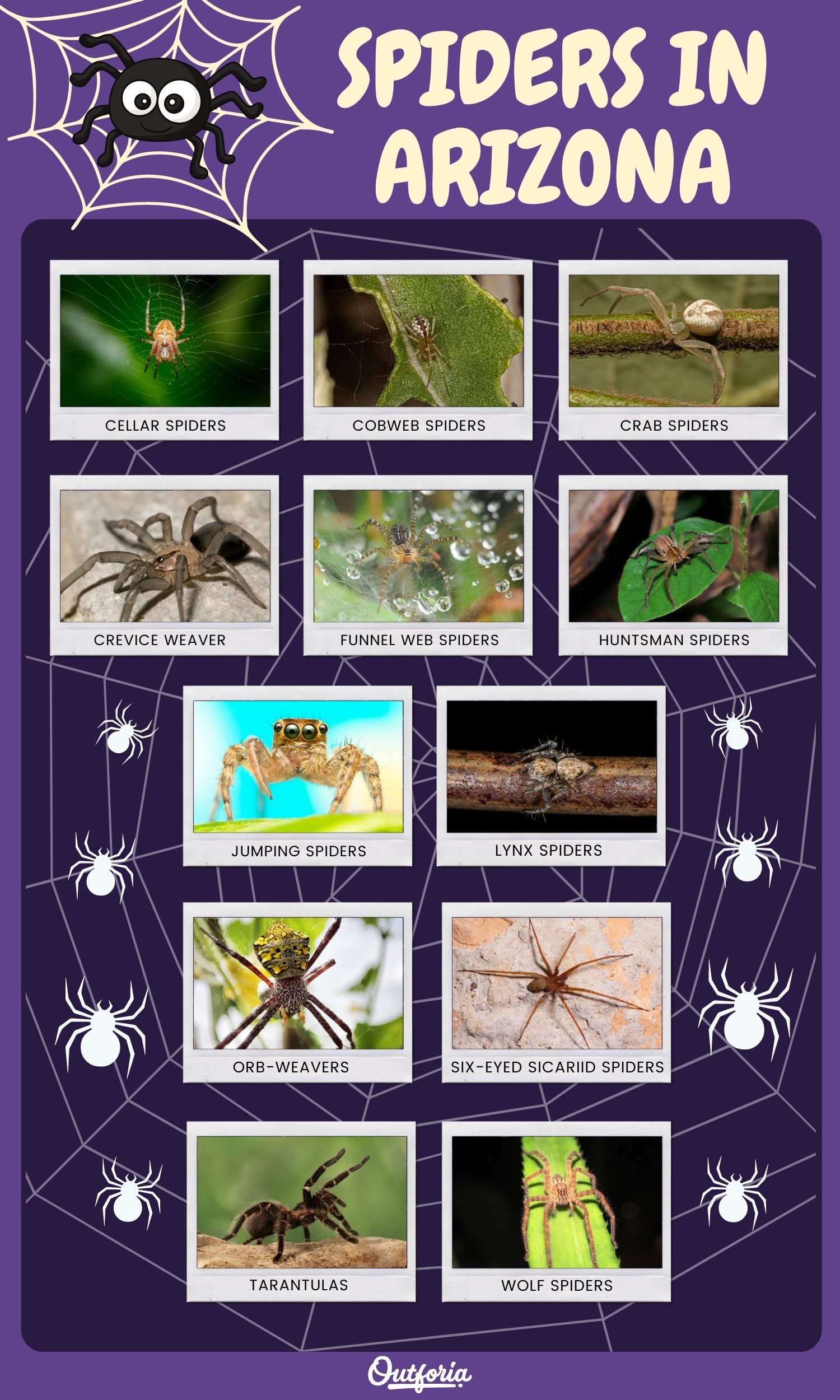
SHARE THIS IMAGE ON YOUR SITE
<a href="https://outforia.com/spiders-in-arizona/"><img style="width:100%;" src="https://outforia.com/wp-content/uploads/2022/10/spiders-in-arizona-infographics-10122022.jpg"></a><br>Spiders in Arizona <a href="https://outforia.com">Outforia</a>You May Also Like: 45+ Most Common Spiders In Texas (With Pictures)
1. Cellar Spiders (Pholcidae)
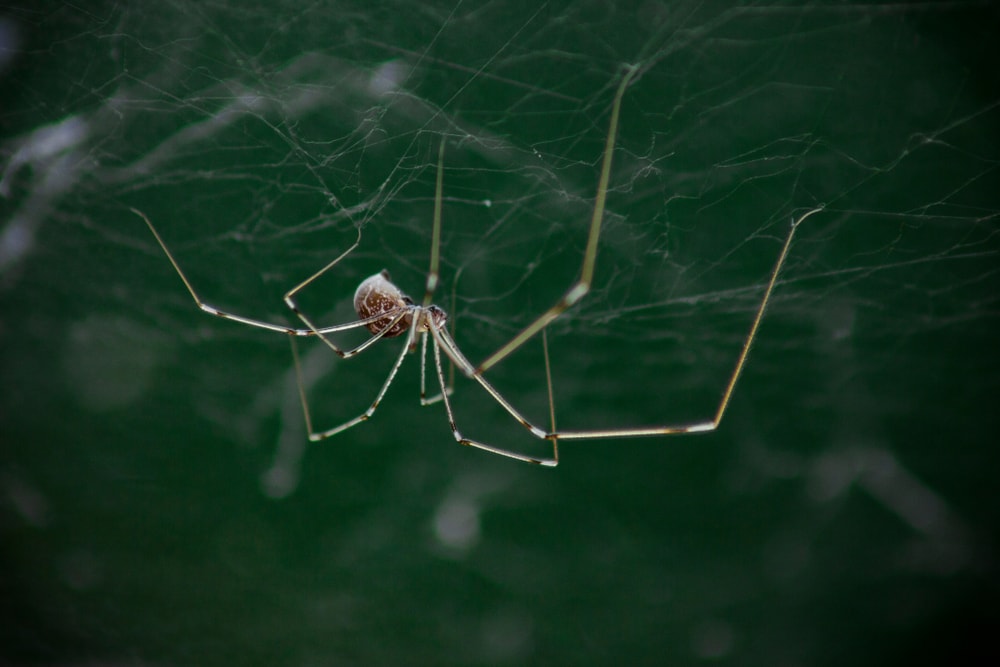
The Pholcidae family of spiders are commonly known as cellar spiders. These spiders are araneomorphae spiders. This means they have pincer-like fangs that point diagonally and cross over. Most spiders fall into this suborder. Pholcidae spiders make their homes in messy webs.
They have long, spindly legs and peanut-shaped bodies. They have two distinct eye patterns, depending on the species. One pattern has a row of four eyes, with two more eyes on each end. The other pattern is two sets of three eyes.
Contrary to popular belief, they do not produce the most toxic venom of all spiders. This family of spiders inflicts no harm on humans.
1.1 Giant Daddy Long Legs Spider (Artema atlanta)
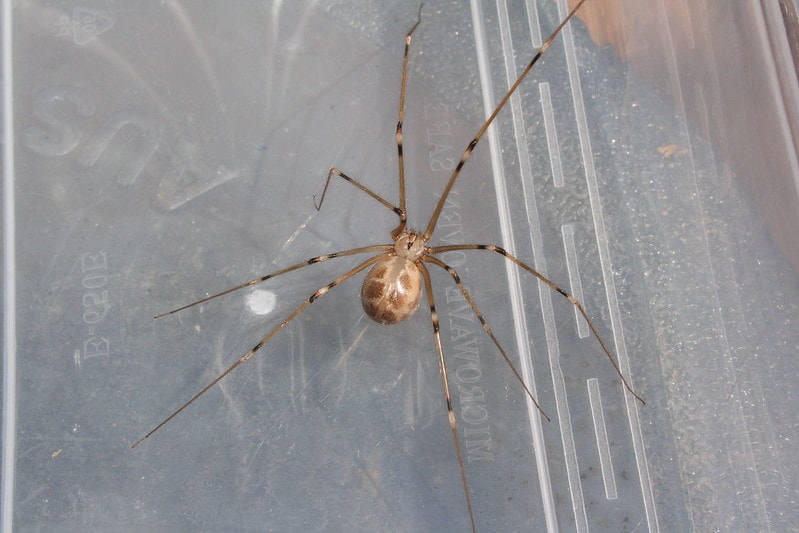
The giant daddy long-legs is an oft misidentified species. It is confused with other arachnids like the harvestmen and crane flies due to the similarity of their legs.
They are the largest of the Pholcidae family, with a leg span upwards of 7 inches (17.8 cm). They are brown-bodied with black chelicerae on the males. They were introduced to the U.S. and made their homes in southern Arizona.
1.2 Marbled Cellar Spider (Holocnemus pluchei)
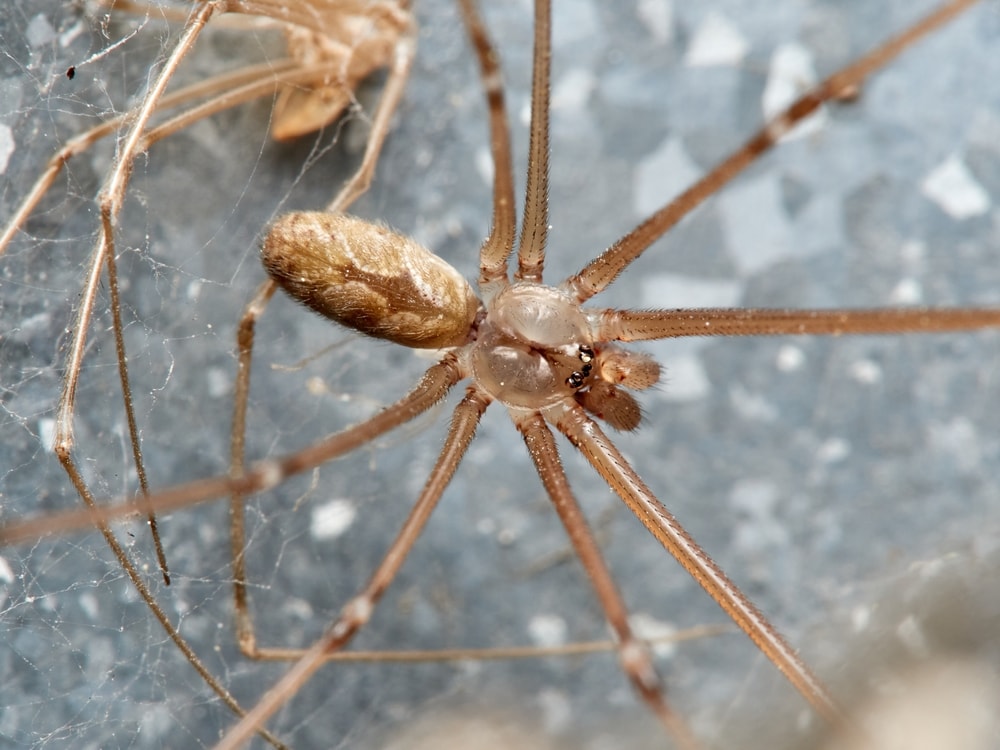
The marbled cellar spider has a black ventral stripe along the underside. This is unique to the species. The typical peanut-shaped bodies are about 0.28 inches (7 mm) with long legs that can span several inches.
The marbled cellar spider tends to live in large groups. These groups create “prey capture sheets” to trap the insects they feed upon.
1.3 Long-bodied Cellar Spider (Pholcus phalangioides)
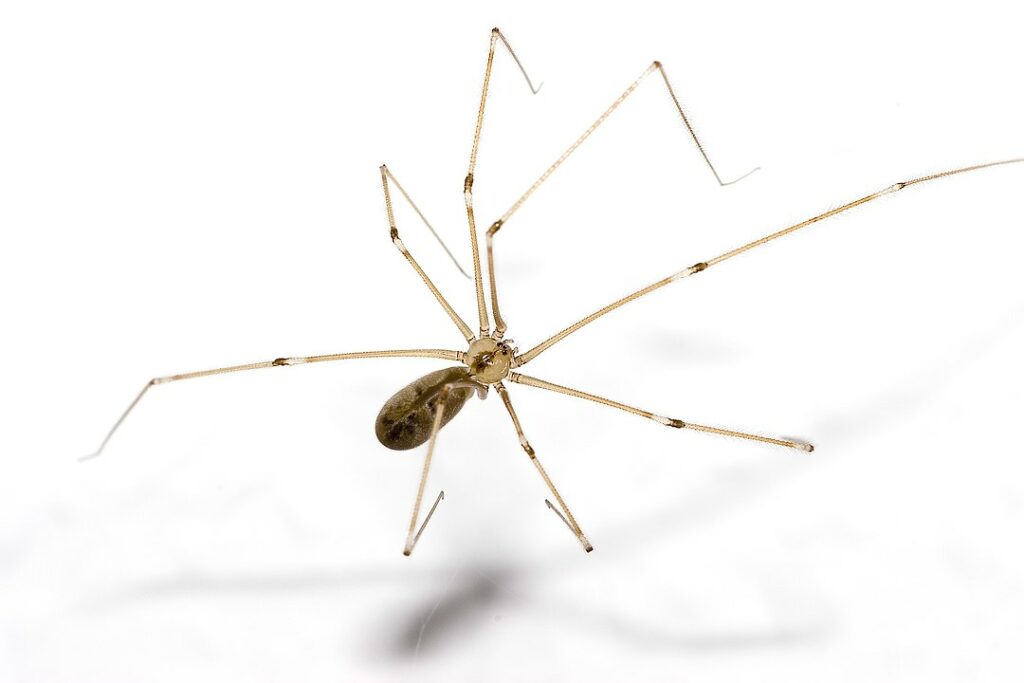
The long-bodied cellar spider is pale yellow or light brown with a gray patch in the center of its back. They are nearly translucent and have long, hairy legs.
Their peanut-shaped bodies are between 0.2 and 0.32 inches (5 and 8 mm), with the females being larger. They feed on small insects and other spiders. When disturbed, they swing in circles from their web by their legs to confuse predators.
2. Cobweb Spiders (Theridiidae)
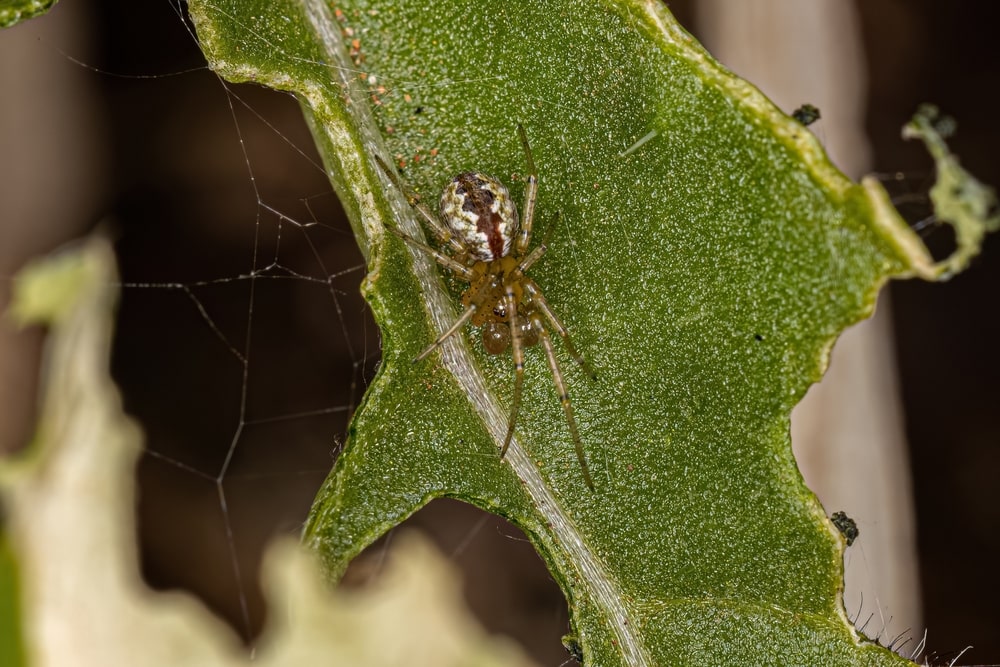
The family Theridiidae are known as tangle-web or comb-footed spiders. They are also araneomorph spiders. They typically have bulbous, globular-shaped bodies and build tangled, messy appearing webs.
Cobweb spiders also have two distinct eye patterns, depending on the species. They both have two rows of four eyes. Some species have small eyes, and some have larger eyes.
Some cobweb spiders have medically significant venom. Scientists study the silk of this family of spiders. It is particularly indestructible and strong.
2.1 Triangulate Cobweb Spider (Steatoda triangulosa)
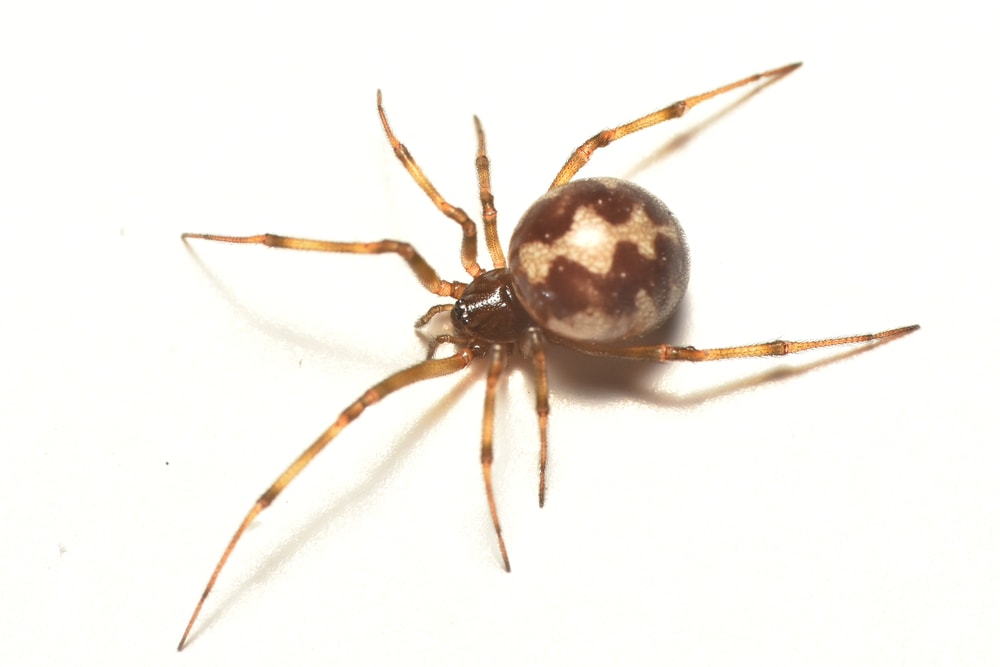
The triangulate cobweb spider is so named for its distinct triangle marking on its back. They are brown-orange with hairy, spindly yellow legs. They are small spiders with bodies up to .25 inches (6 mm).
They do not have good eyesight and rely on web vibrations to alert them to prey caught in their webs. They prey on insects and other spiders, particularly brown recluses. They live in the dark corners of man-made structures.
2.2 Western Black Widow Spider (Latrodectus Hesperus)
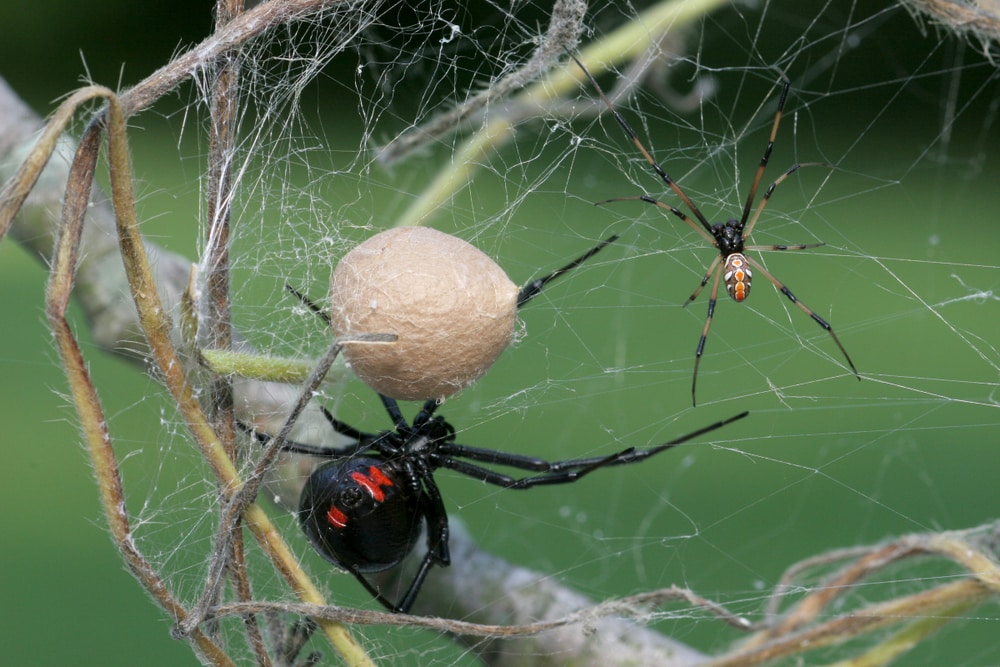
One of the most recognizable and venomous spiders in North America. It has a black, glossy globe-shaped abdomen. And a distinct red hourglass on its underside. This lady practically screams, “No touch!”
The female can be up to half an inch (16 mm) in body length. The males are tan and half her size.
Black widows make very messy-looking webs and lay large egg sacs. These beautiful but potent spiders pack a wallop and will bite when disturbed. The bite feels like gripping hot, searing coals, with long-lasting pain.
However, these bites are not necrotic and are rarely fatal. Most hospitals carry the antivenin. Your best plan is to leave them alone or escort them away from your home.
2.3 False Black Widow Spider (Steatoda grossa)
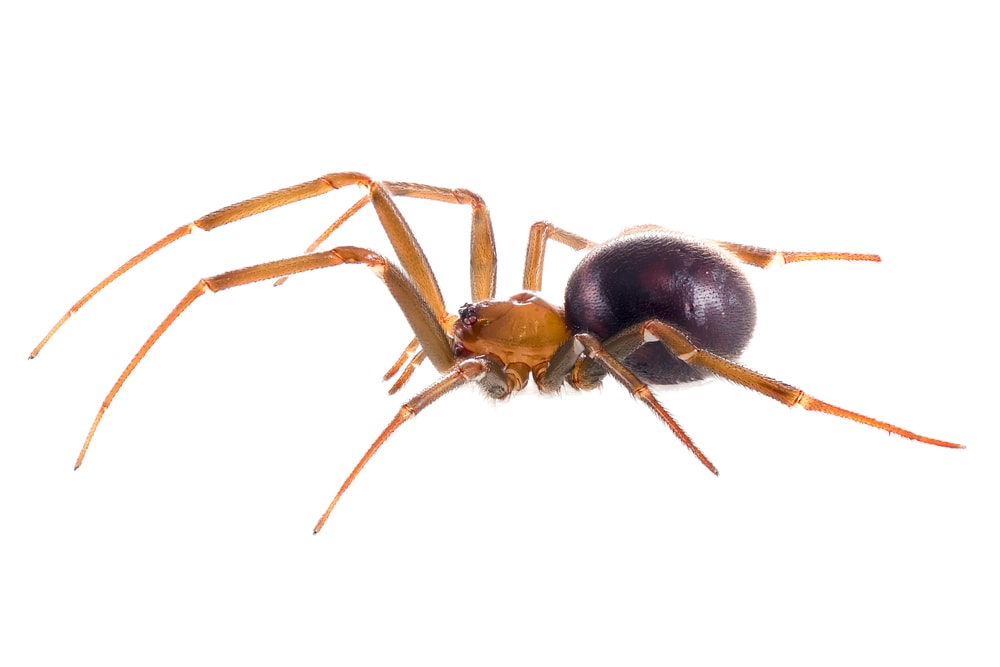
Also called a cupboard spider. This spider has the misfortune of being mistaken for the previous lady. As you can imagine, that mistaken identity often gets it smushed.
As a no-squish family, it’s essential to distinguish between these two similar-looking spiders.
The false widow is about the same size as the real widow but is browner in color. They do not have an hourglass or any other markings on their bellies. The false widow actually preys upon the black widow! Best case scenario, leave this spider to do its business.
Other Black Widow Spiders
- Parasteatoda tepidariorum
- Rabbit Hutch Spider (Steatoda bipunctata)
- Brown Widow (Latrodectus geometricus)
3. Crab Spiders (Thomisidae)
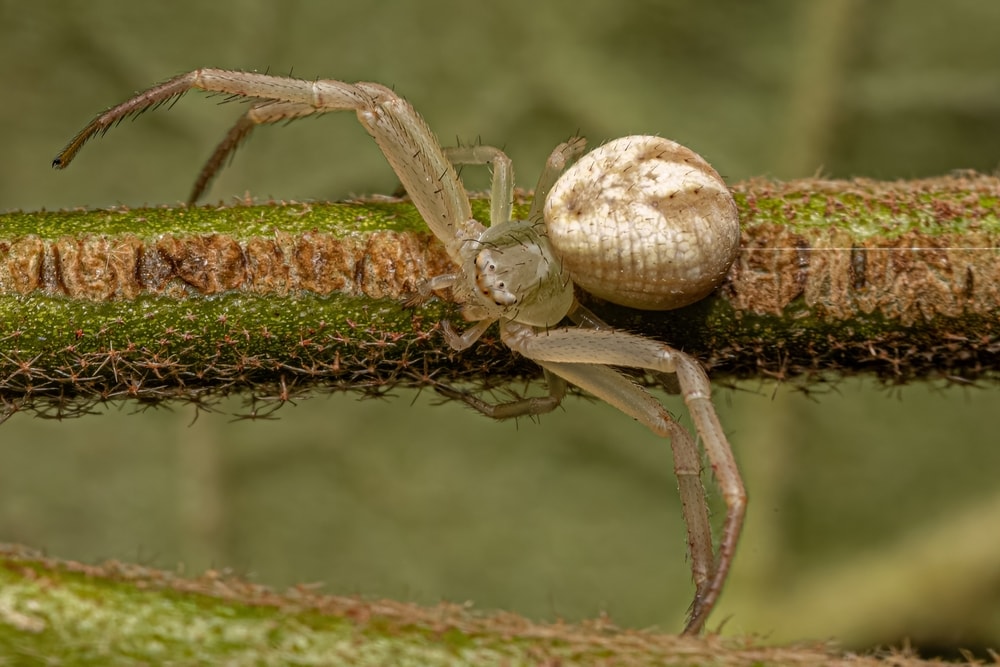
The Thomisidae family of spiders are known as crab spiders, flower spiders, or flower crab spiders. They are so-called because of the way they hold their front legs. They also scuttle about, like crabs.
Crab spiders have a smiley-face eye pattern. A curve of six eyes across the bottom, like a mouth, and two small eyes in the center.
They make their homes in flowers, where they await their prey. They do not create webs to snare their prey. Instead, they wait patiently and pounce on unsuspecting insects. Crab spiders are often brightly colored to camouflage themselves amongst flowers and leaves.
They are a welcome sight in gardens, as they eat insects that feast on plants. If you have a crab spider in your garden, consider yourself lucky!
3.1 White-banded Crab Spider (Misumenoides formosipes)
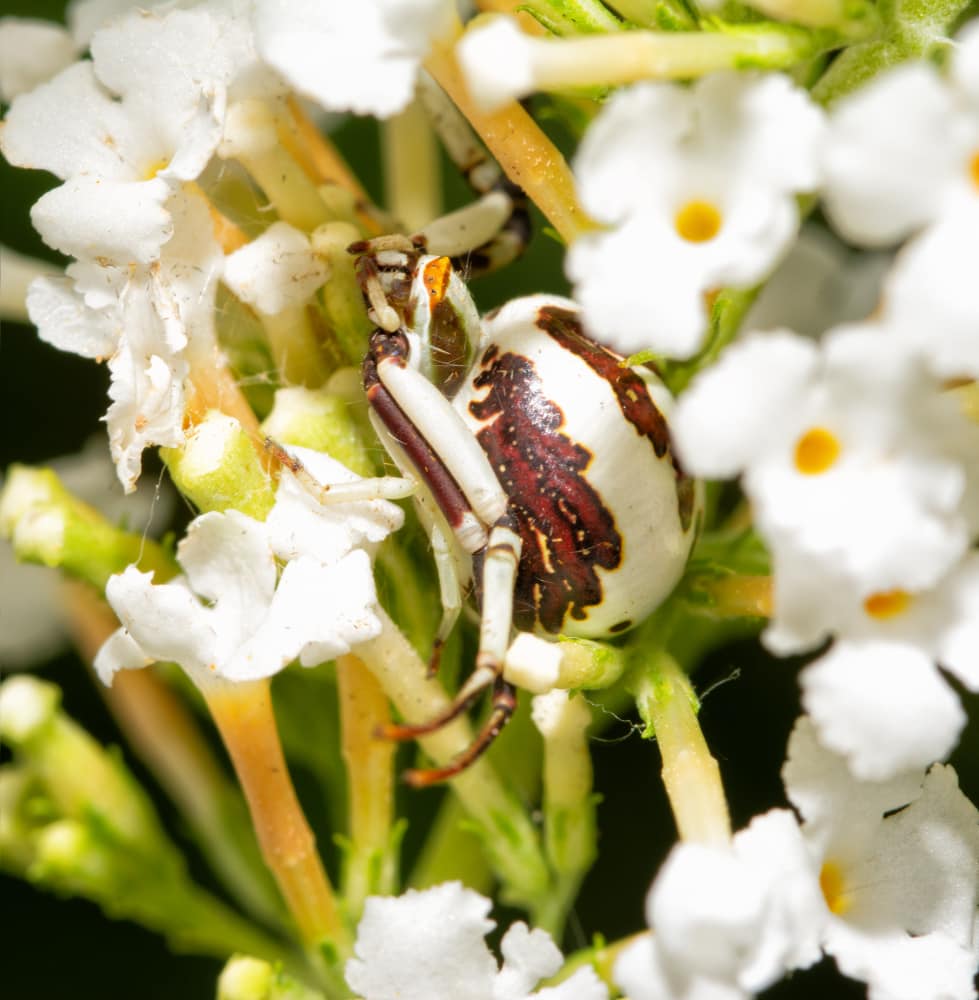
The white-banded crab spider is a colorful species of spider. It can have several color varieties and patterns.
Typically, they are pale yellow or white with dark markings along the back and legs. The females can change their coloring to help them camouflage. This process can take several days.
Females are 0.2 to 0.44 inches (5 – 11 mm), while males are much smaller, about half that size. Males are also much darker and are unable to change their colors. The males feed off the nectar of flowers while the females eat insects. The female will lay an egg sac containing up to 180 eggs and guard it until she dies.
3.2 Goldenrod Crab Spider (Misumena vatia)
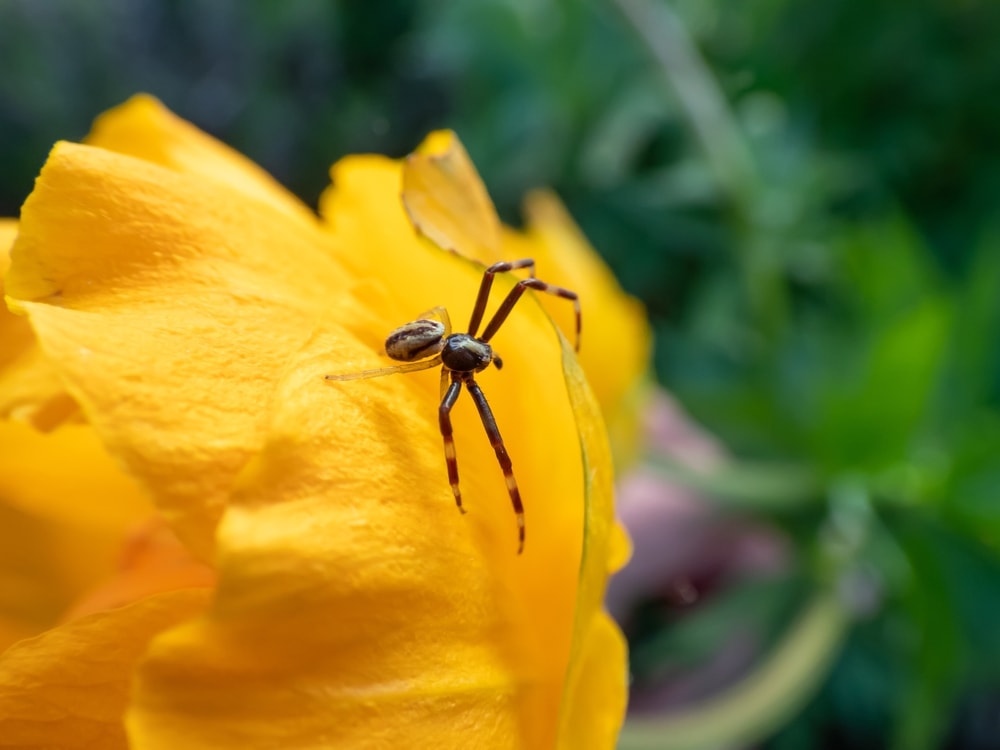
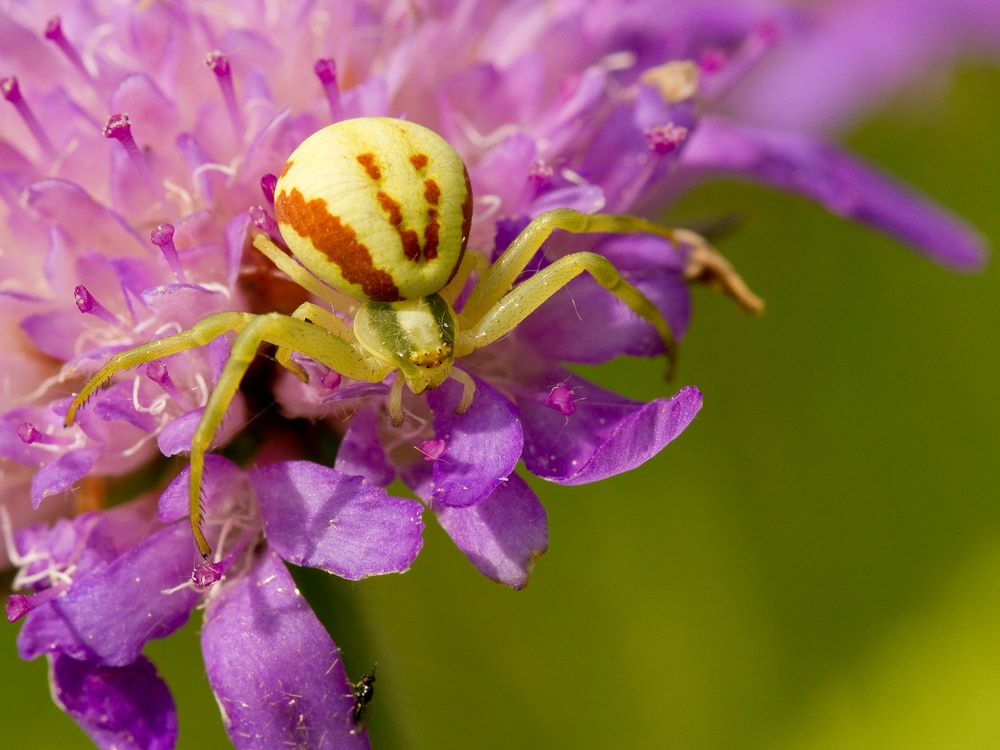
The goldenrod crab spider is similar in appearance and behavior to the white-banded crab spider.
However, the body markings are further to the sides of the body and may be pink or purple in color. The females can change color depending on the flower they are on.
The goldenrod spider is an extreme example of sexual dimorphism. Females are 0.25 inches (6 mm), while males are a third of this size. The males look like completely different spiders! They are darker, with two sets of dark legs and two sets of yellow legs.
These spiders depend on their good vision for hunting, as they do not build webs. Females lay their egg sacs and guard them. They usually die shortly after the eggs have hatched.
Other Crab Spiders
- Deadly Ground Crab Spider (Xysticus funestus)
- Xysticus californicus
4. Crevice Weaver (Filistatidae)
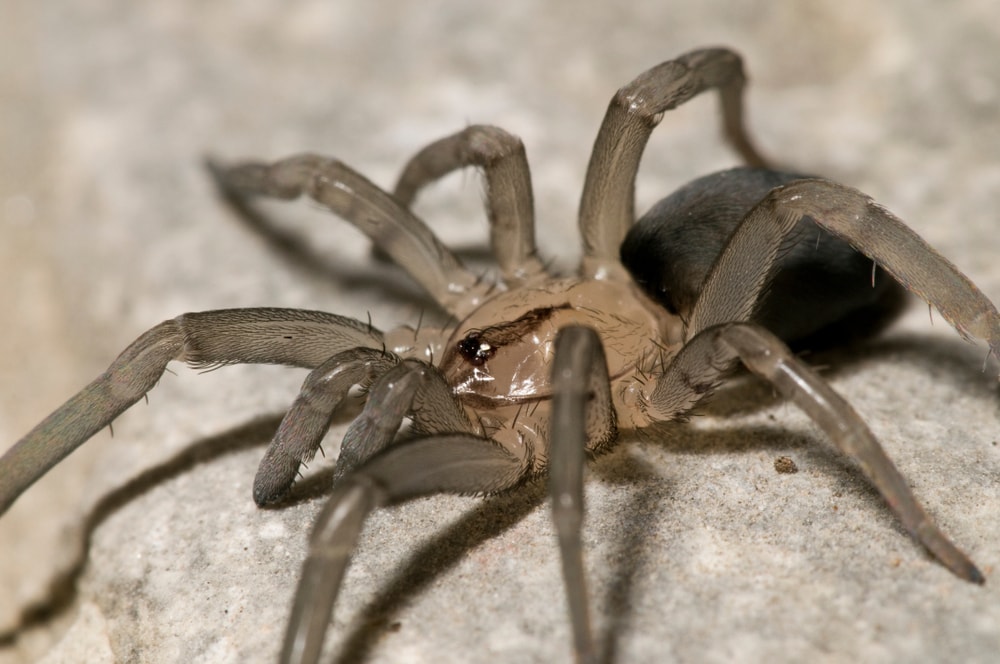
Crevice weaver spiders are a “primitive” family of spiders. This means they have traits that have not changed much since they first appeared.
For these spiders, that trait is that they are cribellate spiders. This means they have cribellum. Cribellum are silk-spinning organs that are made up of tiny spigots. This produces extremely fine and wooly silk fibers.
They also have a unique upward bend of their legs. This bend helps them to latch on their prey and pull it from its hidey-hole. They can also grab onto the walls of its hide to prevent themselves from being captured.
Crevice weavers make their lairs in crevices, as one might expect. Those crazy legs also come in handy for digging their burrows.
4.1 Southern House Spider (Kukulcania hibernalis)
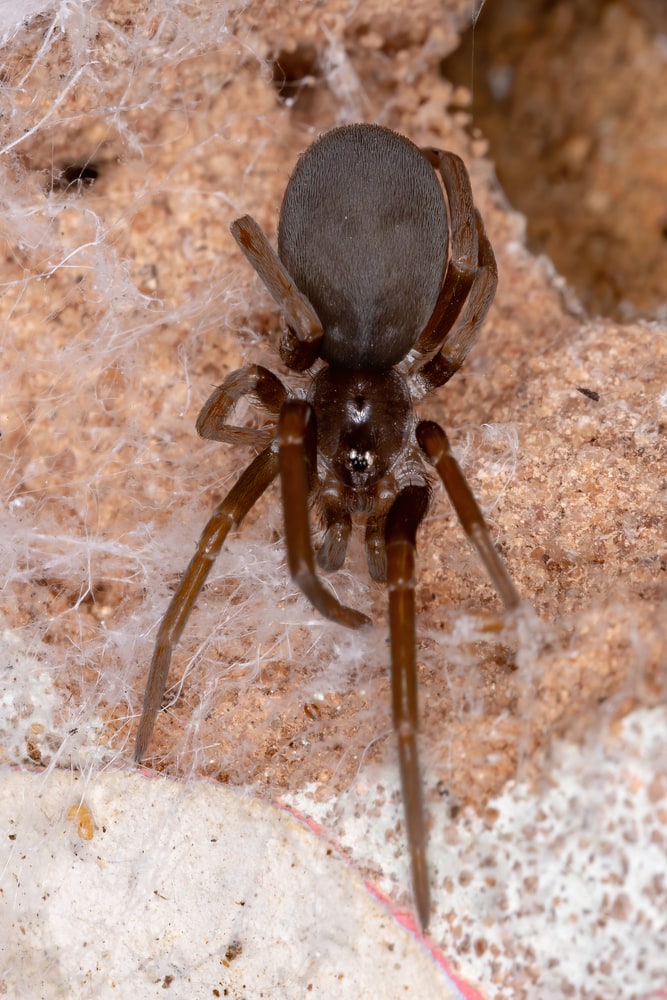
The southern house spider is a dark brown spider with a body covered in fine hairs. They are often misidentified as brown recluses due to their similar shape and color.
However, they do not have the recluse’s distinct violin shape on its back. The males of this species are the larger spiders and can be up to 2 inches (5.1 cm), including their legs.
The females spend most of their time in their webbed burrows and are rarely seen. The males are much more mobile, constantly on the move to find a mate. These spiders do not attack humans.
But they have poor eyesight and may bite when threatened. Usually, though, when cornered, they will play dead.
4.2 Arizona Black Hole Spider (Kukulcania arizonica)
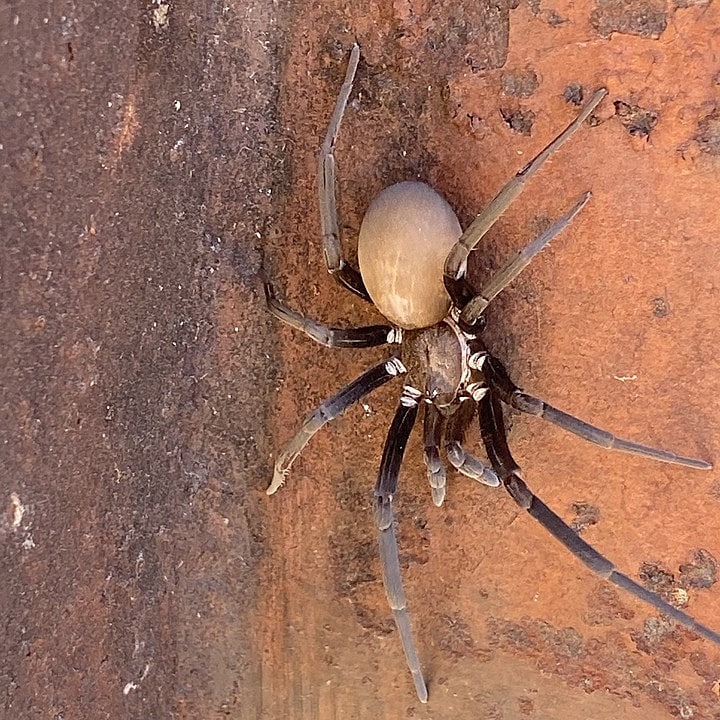
The Arizona black hole spider sounds like a terrifying creature that lurks in the night, and it kind of does. However, they aren’t really terrifying. They get their name from the Mesoamerican serpent goddess, Kukulkan. This black, velvety spider grows up to 0.7 inches (18 mm), not counting its legs.
They live in tube-like burrows that they line with their unique webbing. Often these holes are found along wall crevices. They resemble something from a sci-fi movie. The strange web tendrils radiate out of the hole in a tangled pattern.
5. Funnel Web Spiders (Agelenidae)
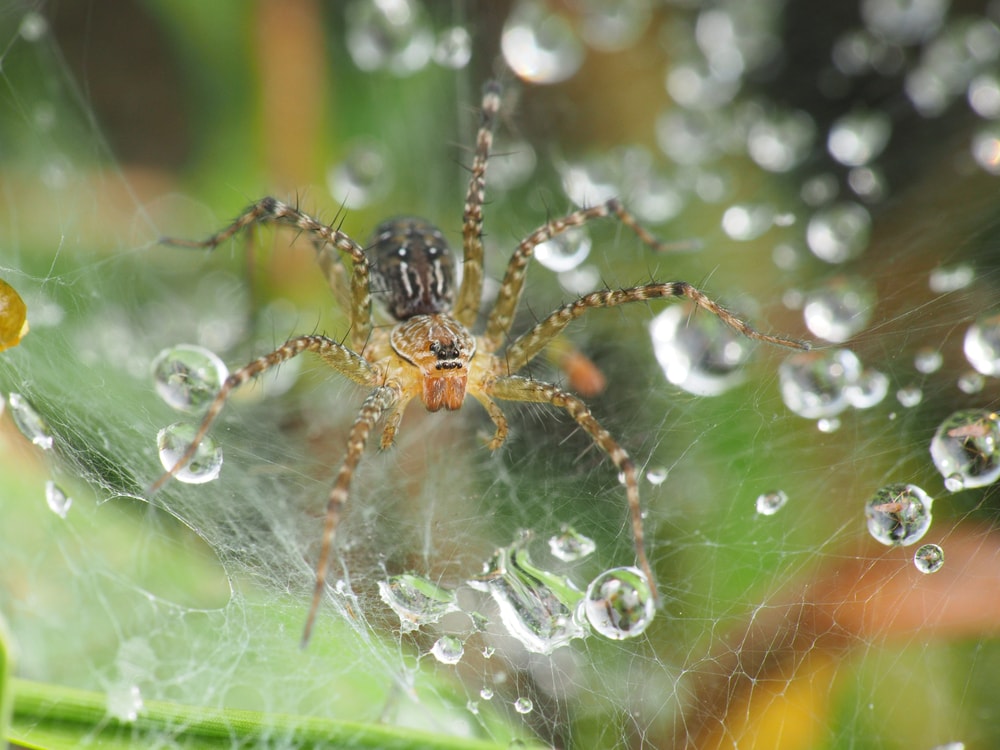
The family Agelenidae are commonly known as funnel web spiders. They are not the same family as trapdoor spiders. Instead, they use their silk to create sheet webs. These sheet webs attach to grasses and structures to trap their prey.
The funnel moniker comes from the funnel-shaped hide in the corner of the sheet web. Aglenidae are very fast-moving spiders. They have excellent eyesight. There are two distinct eye patterns, with eight eyes in total.
One pattern features three rows of eyes; two on top, four in the middle, and two on the bottom. The other pattern is one row of six eyes and two above.
5.1 Giant House Spider (Eratigena atrica)
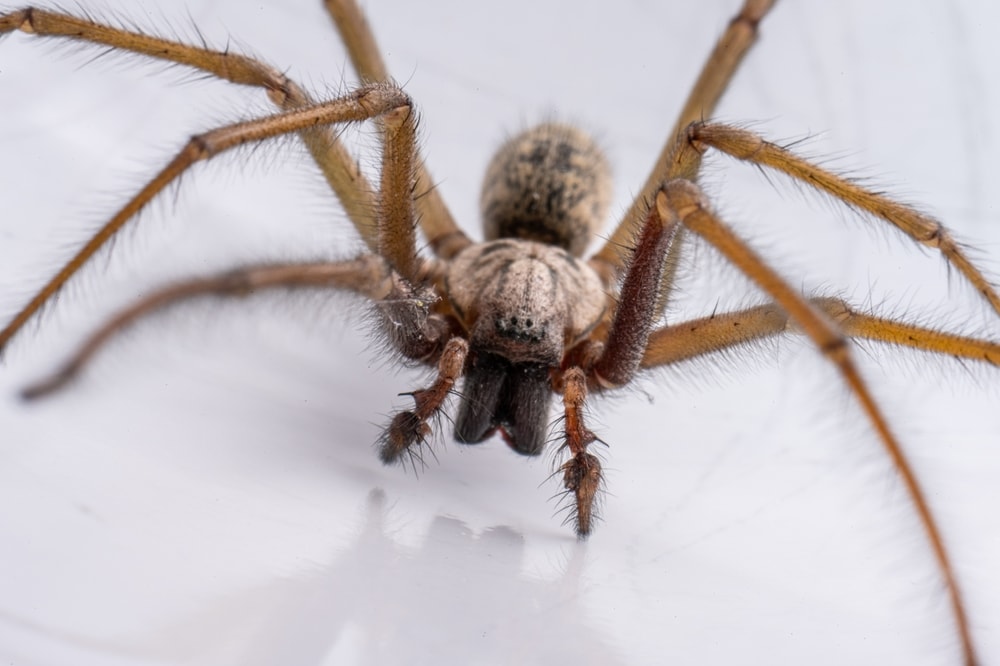
The giant house spider is one of the largest funnel web spiders in the U.S. It is 2 to 4 inches (5 to 10 cm) in total leg span.
They are mostly brown with a dark reddish-brown head and legs. They also have a distinct light pattern of three arrows on their back.
The giant house spider is a speedy fella. It has been clocked at 1.73 ft/s (0.53 m/s) and once held the Guinness Book of World Records title for top spider speed until 1987. Sadly, it lost the title to the camel spider. This seems unfair, considering the camel spider isn’t even an actual spider!
5.2 Hobo Spider (Eratigena agrestis)
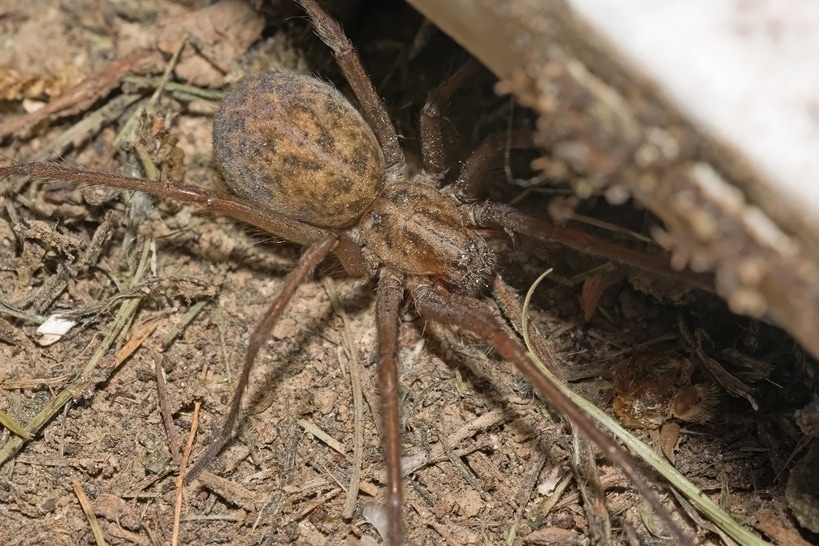
The hobo spider has the reputation of being a danger to humans. And yes, they do have medically significant venom. However, there have been no incidents involving the hobo spider in over 35 years.
In fact, the CDC has removed them from their “dangerous spiders” list. Hobo spiders are difficult to identify and closely resemble several other spider species.
They are rather large, up to 2 inches (5 cm), including legs. They are unremarkable brown spiders with dark V-shaped patterns on their abdomens. Despite looking like wolf spiders and grass spiders, hobo spiders lack leg bands and dark parallel body stripes.
6. Huntsman Spiders (Sparassidae)
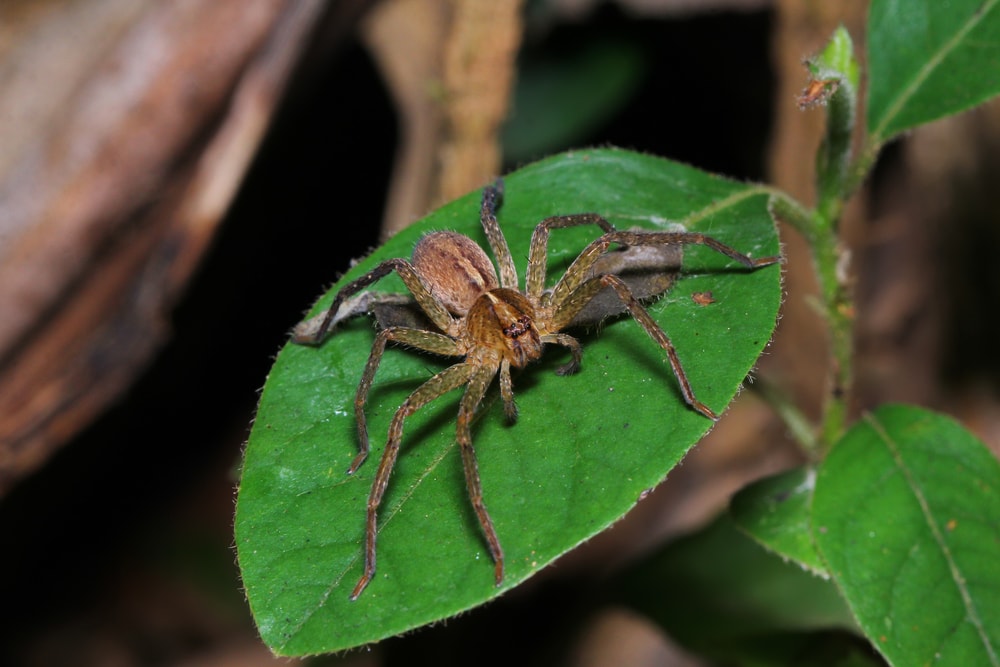
The Sparassidae family of spiders has a reputation for being very large spiders. The giant huntsman, a cave spider only found in a singular cave in Laos, is tied for the largest living spider. Measuring its leg span, it is 12 inches (30.48 cm)! That is a BIG spider!
Huntsman spiders are hunting spiders, as you might expect. They have forward-curving legs. This gives them the nickname “crab spider” because they resemble crabs when resting. They are extremely fast spiders with poor eyesight.
6.1 Giant Crab Spider (Olios giganteus)

We affectionately call this spider “Scary Gary” because it is so fast and agile. The giant crab spider is commonly found throughout Arizona, often seeking shelter in homes. They measure about 6 inches (15.24 cm), including their legs.
Giant crab spiders are harmless to humans. But their speed and apparent lack of fear of humans make them a bit frightening. They can cling and climb to most surfaces due to their hairy legs and sticky feet.
This makes them difficult to shoo along if they happen to skitter across you. The best bet is to let the spider move along on its own instead of helping.
7. Jumping Spiders (Salticidae)
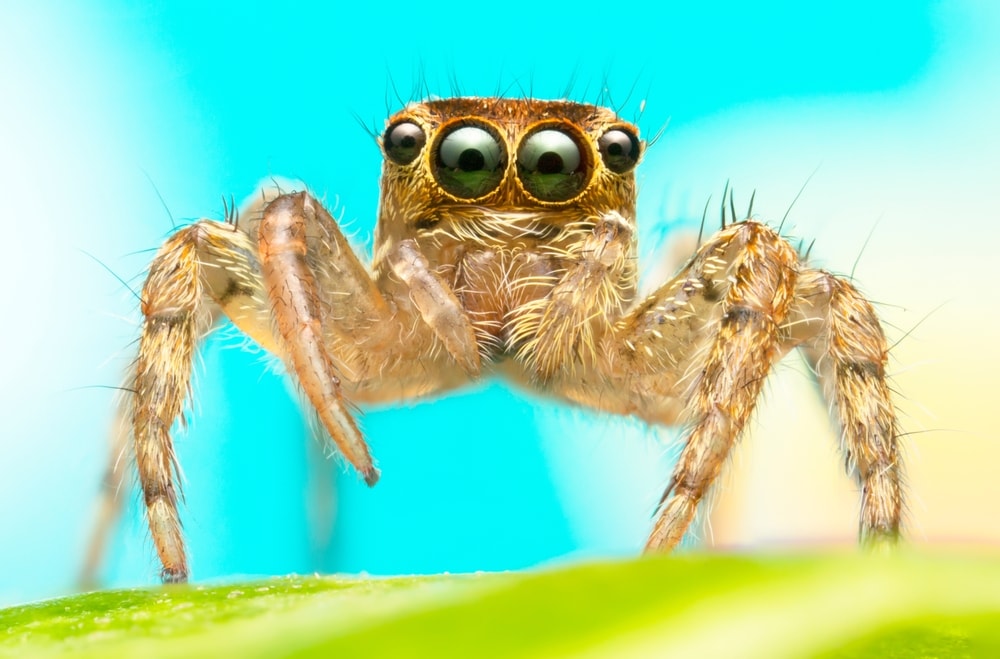
With over 5,000 identified species worldwide, the Salticidae family is the largest family of spiders. They are also the cutest! They are small, curious spiders. They have found their way into the hearts of even the most rigid arachnophobe.
They have a distinct eye pattern that features two big eyes flanked on each side with three smaller eyes. They have excellent eyesight.
Perhaps their huge central eyes and curious demeanor set these spiders apart from others. Whatever it is, these little critters are fun to observe as they stalk and hunt their prey. Jumping spiders make great pets, even though they have a short one to two-year spider lifespan.
7.1 Pantropical Jumping Spider (Plexippus paykulli)
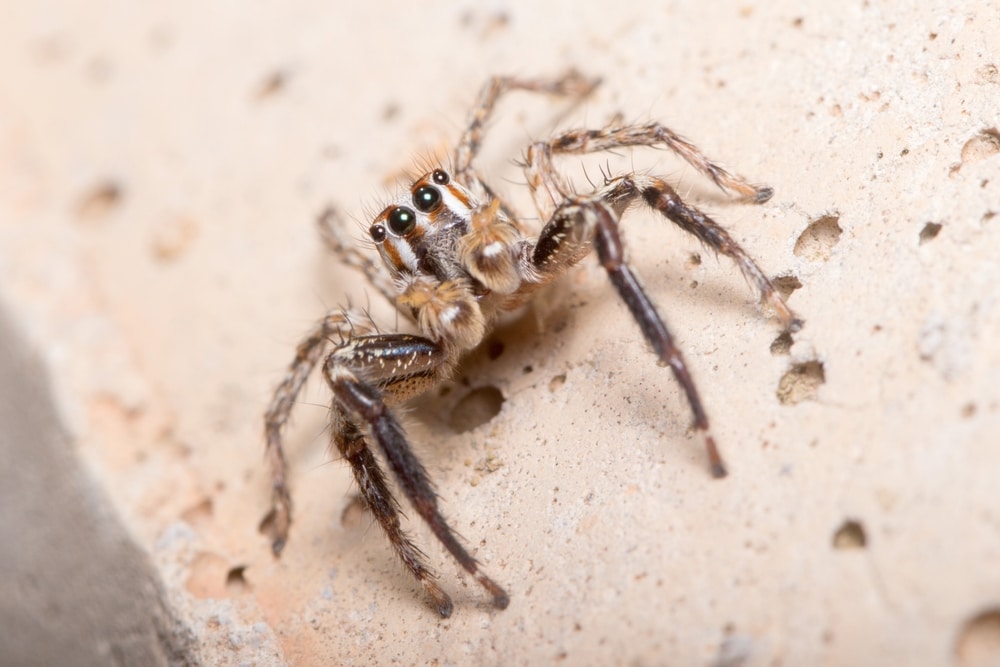
The pantropical jumping spider is small, less than half an inch (12mm) in length. The females are brownish gray with chevron patterns on their backs. They have two white spots on their bums.
The males are slightly smaller and mostly gray. They have distinct white and black stripes along their backs.
P. paykulli make their homes on man-made structures or in trees. They do not spin webs but create silk hammocks where they retreat. They will stalk their prey, changing up their hunting strategy if unsuccessful.
7.2 Phidippus carneus
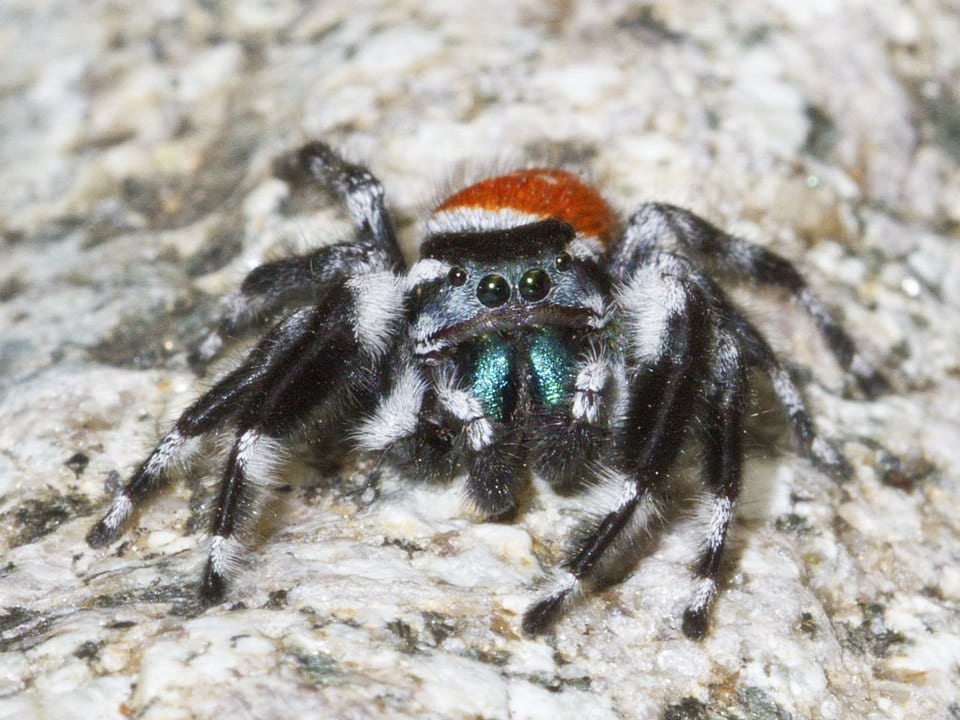
The P. carneus is a medium-sized red and black jumper. They are about 0.67 inches (1.7 cm) in size. They have distinct white bands on their black legs and a white ring on their abdomen. This sets them apart from other similar-looking red and black jumpers like the Johnsoni.
These little cuties tend to live under rocks and stalk their prey. They have excellent eyesight and can jump long distances to snatch up insects. They feed on flies and fly larvae.
7.3 Emerald Jumping Spider (Paraphidippus aurantius)

The emerald jumper displays its namesake with a brilliant metallic green stripe along its back. The males are black with white stripes along the head and on either side of their abdomen. The females are brown with orange markings instead of white.
These flashy spiders are medium jumping spiders, coming in at nearly half an inch (12 mm). The males are slightly smaller. Like other jumping spiders, the emerald is a fantastic hunter. They will leap great distances to pounce on their prey.
Other Jumping Spiders
- Apache Jumping Spider (Phidippus apacheanus)
- Habronattus clypeatus
- Habronattus pyrrithrix
- Hirsute Paradise Spider (Habronattus hirsutus)
- Regal Jumping Spider (Phidippus regius)
- Ribbon Jumping Spider (Metacyrba taeniola)
- Salticus palpalis
- Phidippus johnsoni
- Agave Jumping Spider (Paraphidippus basalis)
- Colonus hesperus
8. Lynx Spiders (Oxyopidae)
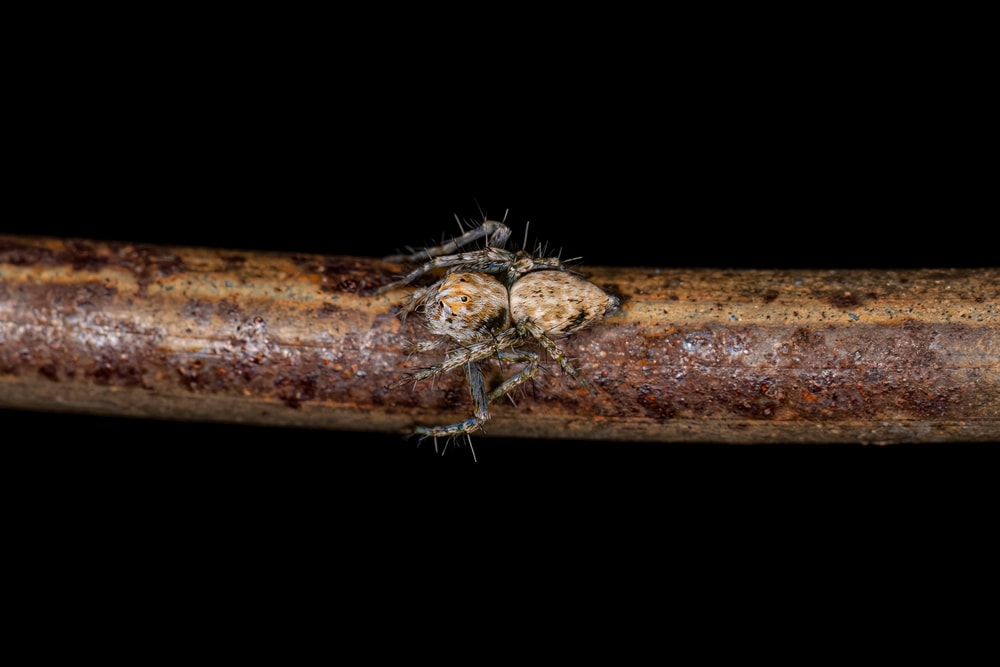
The Oxyopidae family of spiders are keen hunters. They use their excellent eyesight to stalk prey.
They have a distinct three-row eye pattern with four eyes in the center and two above and below. They use their camouflage to hide amongst plants to ambush their prey.
While they are mostly ambush hunters, they can run and leap on prey with ease. They use their hairy legs to help grasp their prey and hold on while they eat. They feed on caterpillars and other larvae. In large numbers, their feeding habits prove beneficial to humans. They keep these crop-destroying pests at bay.
8.1 Green Lynx Spider (Peucetia viridans)

The green lynx spider is often found hiding amongst green leaves and plants. They are translucent green with long, hairy legs. The green lynx is a rather large spider.
The females grow up to about 0.87 inches (22 mm). The males are only about half that size.
They are beneficial to crops, as they eat caterpillars that destroy plants. The females will defend their egg sacs with a spray or spit of venom. They are the only lynx species that does this. Contrary to popular belief, the green lynx spider does not spit venom at humans unprovoked.
Other Lynx Spiders
- Lesser Green Lynx Spider (Peucetia longipalpis)
- Western Lynx Spider (Oxyopes scalaris)
- Striped Lynx Spider (Oxyopes salticus)
9. Orb-Weavers (Araneidae)
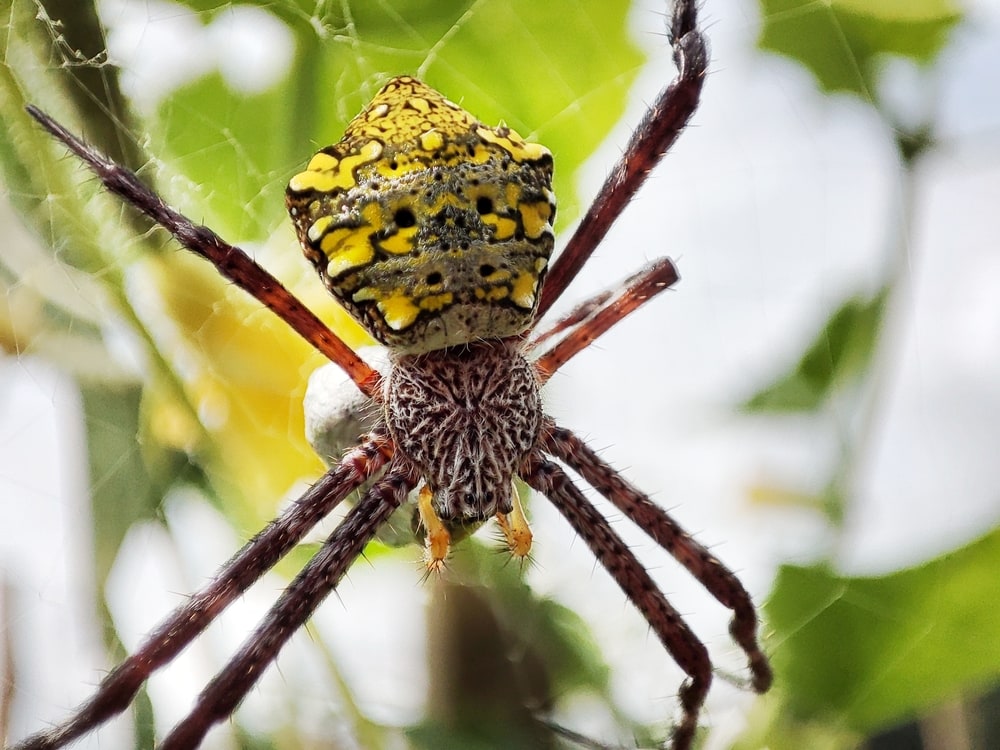
The Araneidae family of spiders is the third largest. They are one of the most unique and diverse of all spider families. They are so named because of their ability to create intricate circular webs.
The webs they weave are what we typically think of when we imagine spiderwebs. Think Charlotte’s Web for an example of an orb weaver web. Well, without the words spun into them, of course!
Orb weavers tend to be fanciful and colorful. They artfully spin webs in the early evening, delicately dancing across their creations. These webs catch prey like a net throughout the night. Then the orb weaver will consume their web in the early morning hours. Then they retreat until night falls again.
9.1 Banded Garden Spider (Argiope trifasciata)
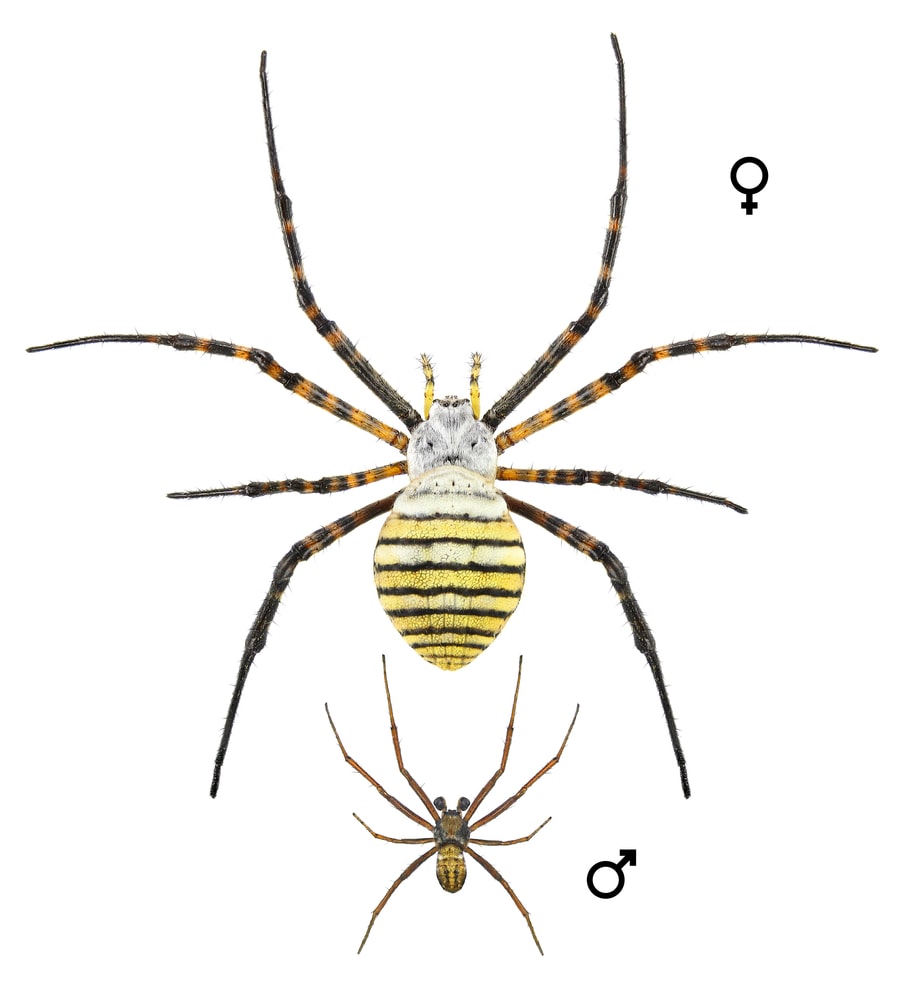
The banded garden spider is a common sight in gardens and yards across Arizona.
The females are brightly colored, with bands of white, black, and yellow striping their abdomens. They have deep orange legs with black bands. Their bodies are about an inch (2.5 cm) long with 2-inch (5 cm) legs. The males are much smaller and more muted in coloring.
The females typically spin webs 24 inches (61 cm) in diameter. Although massive 6-foot (1.83 m) webs have been observed. They sit in the center of the web, with their legs in an x-shape to wait for prey. The males build smaller webs nearby their mate.
9.2 Hentz Orb Weaver (Neoscona crucifera)
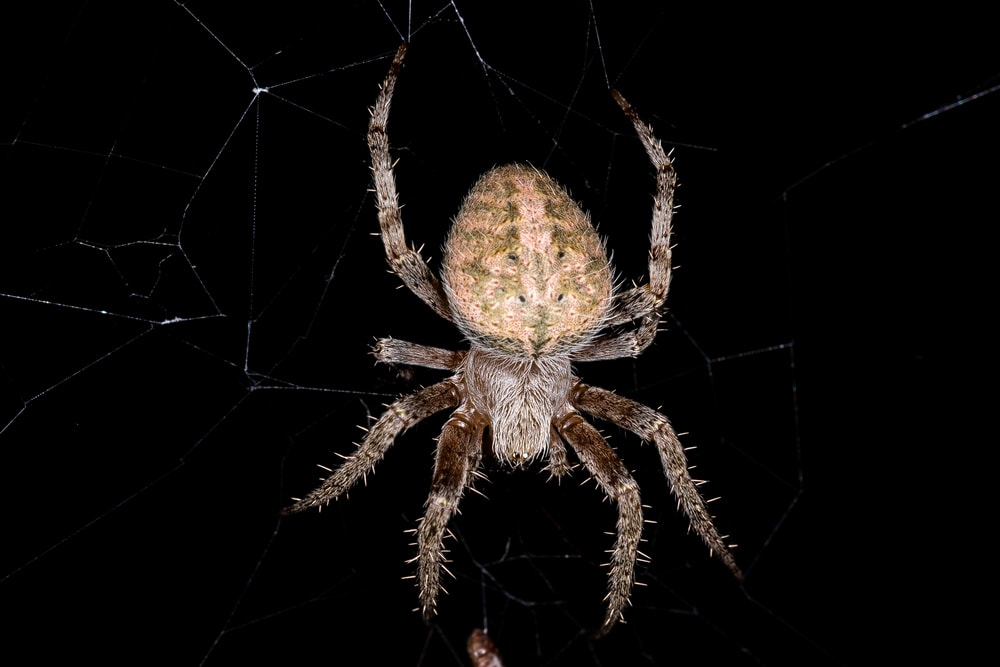
The Hentz or spotted orb weaver is another common night visitor in Arizona. They are about 1.5 inches (2.54 cm), including the legs. They have a brown or rusty red hairy body with two white spots on the underside. They have brown and black banded legs.
They create large webs, up to 2 feet (0.3 m) in diameter. They build their webs between tall grasses or man-made structures. They spin their intricate webs daily, consuming them each morning.
They are generally nocturnal but often become diurnal in the fall. The reason is not fully understood. But it’s thought to be due to the lack of insect activity in cooler fall nights.
Other Orb-Weavers Spiders
- Cat-Faced Spider (Araneus Gemmoides)
- Larinioides Cornutus
- Western Spotted Orb Weaver (Neoscona oaxacensis)
- Yellow Garden Spider (Argiope aurantia)
- Shamrock Spider (Araneus Trifolium)
- Banana spider (Trichonephila clavipes)
- Arabesque Orb Weaver (Neoscona Arabesca)
10. Six-eyed Sicariid Spiders (Sicariidae)
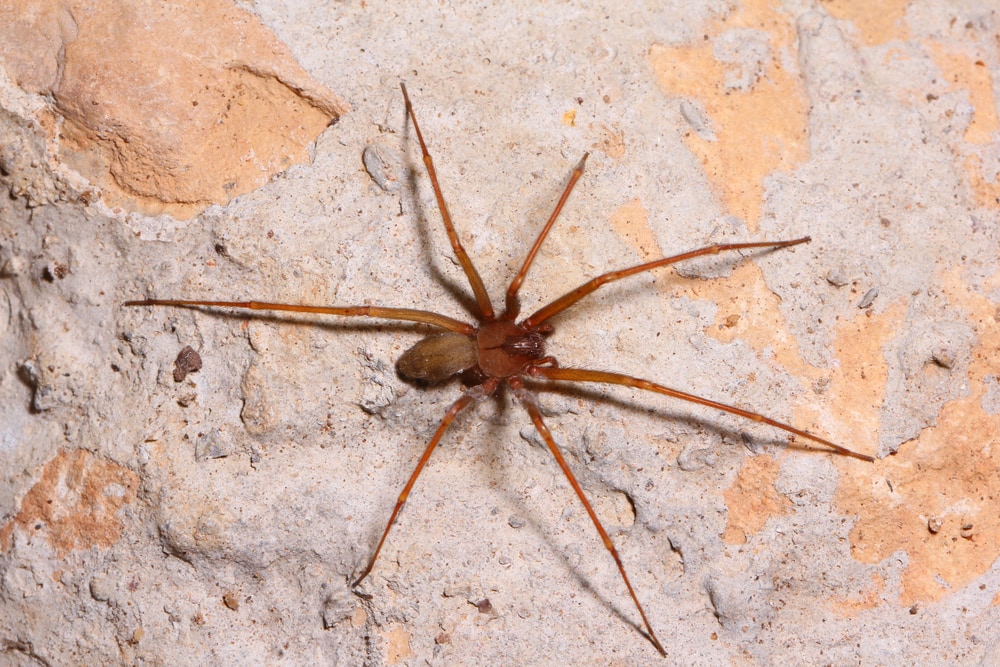
The Sicariidae family of spiders is a large family. It includes recluse spiders, violin spiders, six-eyed sand spiders, and assassin spiders.
These spiders have six eyes in a distinct two by two by two pattern. They are known to be highly venomous and can give a necrotic bite. However, like most spiders, they want nothing to do with humans and only bite in defense.
10.1 Arizona Brown Spider (Loxosceles arizonica)
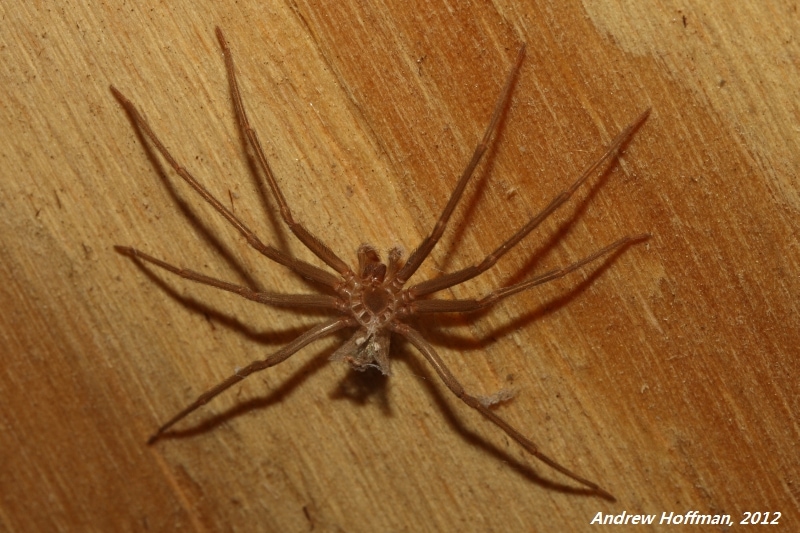
The Arizona brown spider is native to the state. It is a small spider, only 0.33 inches (8.4 mm). They have yellowish-brown bodies. They have pale brown to violet violin-shaped markings on their heads. Like other spiders in the Sicariidae family, they are reclusive and keep to themselves.
They make their homes near cacti, in rocky, dry locations. This spider primarily eats ants, especially carpenter ants. They do have a painful bite, with the possibility of necrosis. But they are not actively seeking to harm humans.
10.2 Brown Recluse (Loxosceles reclusa)
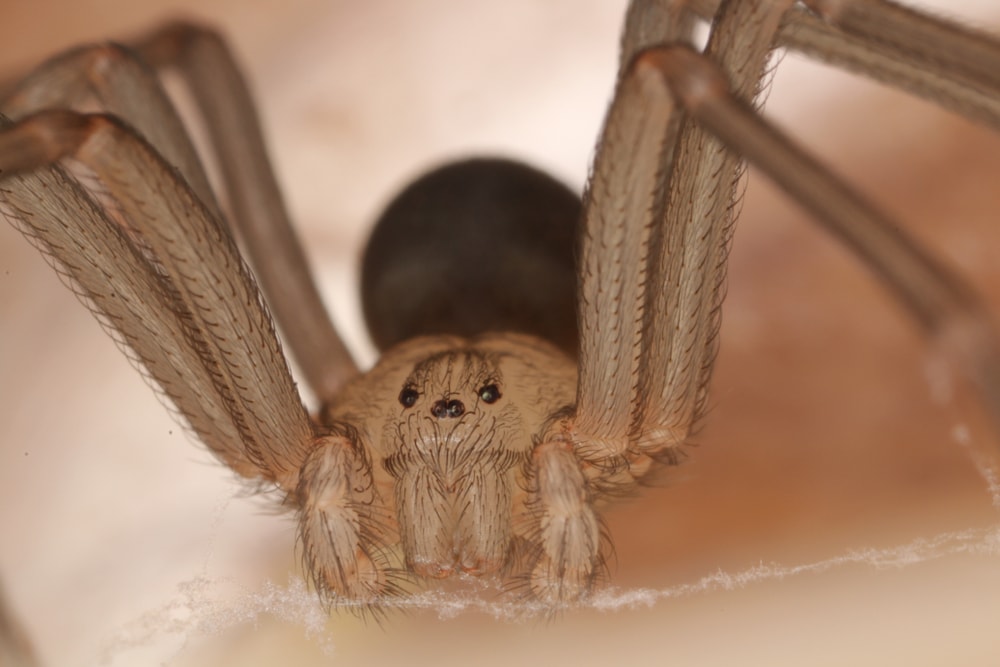
Outside of the black widow, the brown recluse is the most formidable spider in Arizona. This quarter-sized spider strikes fear and loathing in the hearts of many.
For good reason, I suppose. Their bite is extremely painful and can cause skin necrosis. My cousin will tell you all about it!
However, this spider is just doing what Sicariidaes do. They hide and lurk in dark, undisturbed places, waiting for unsuspecting prey to leap upon.
They are tan to brown, sometimes with a gray sheen. They do not have any hairs on their lanky legs. They do have a dark, violin-shaped pattern on their abdomen.
Take precaution when working outdoors or in dark, undisturbed indoor areas. Wear gloves and look before putting your hands under or behind objects. The best way to avoid a spider bite is to avoid the spider. They will only bite when they feel threatened.
11. Tarantulas (Theraphosidae)
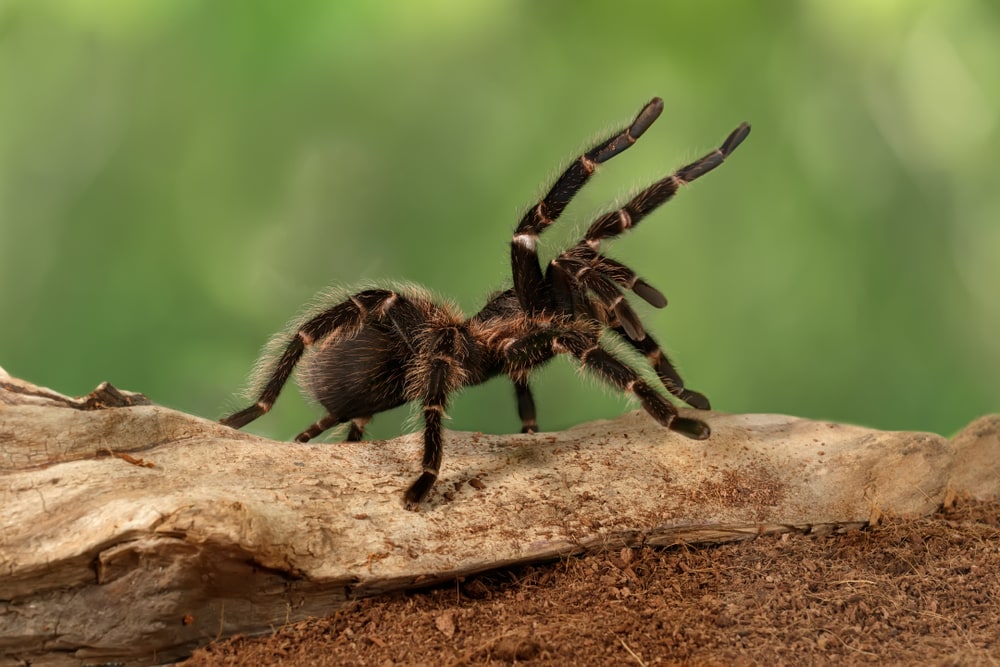
Tarantulas are some of the largest spiders on the planet. They are also one of the most recognizable.
They have large, heavy bodies and thick legs covered in hair. They are usually about 4 inches (10.16 cm), but some species can grow as large as 12 inches (30.48 cm).
Despite their large size, tarantulas are very docile and elusive. They have become popular exotic pets over the past decade or so, and for good reason! Their gentle demeanor and low maintenance level make them ideal pets for all ages and skill levels.
Tarantulas are mygalomorph spiders. This means they have parallel fangs that go up and down instead of diagonally, like most spiders. They use these powerful fangs to crush their prey into edible goo.
Different species prefer different living quarters. Some prefer to live in trees. But most tarantulas in Arizona prefer to live in burrows.
Arizona is home to several species of tarantula. Most of them have a very isolated range and are rarely observed.
11.1 Arizona Blonde (Aphonopelma chalcodes)
The Arizona blonde tarantula is the most common tarantula in Arizona. They are sometimes called Western desert tarantulas. They are large-bodied tarantulas, growing up to 5 inches (13 cm). They are mostly brown, with pale brown carapaces. This is where the blonde moniker comes from.
They make deep burrows amongst rocks. They have been observed underwater in their burrows during flash floods.
In the spring, you may encounter males en masse seeking out mates. When males reach maturity, they search for a female to mate with.
After their final mature molt, males will no longer eat. Their only mission is to find a mate and die. Tarantulas have very long lifespans. The females can live up to 25 years, while the males live about 5.
11.2 Grand Canyon Black Tarantula (Aphonopelma marxi)
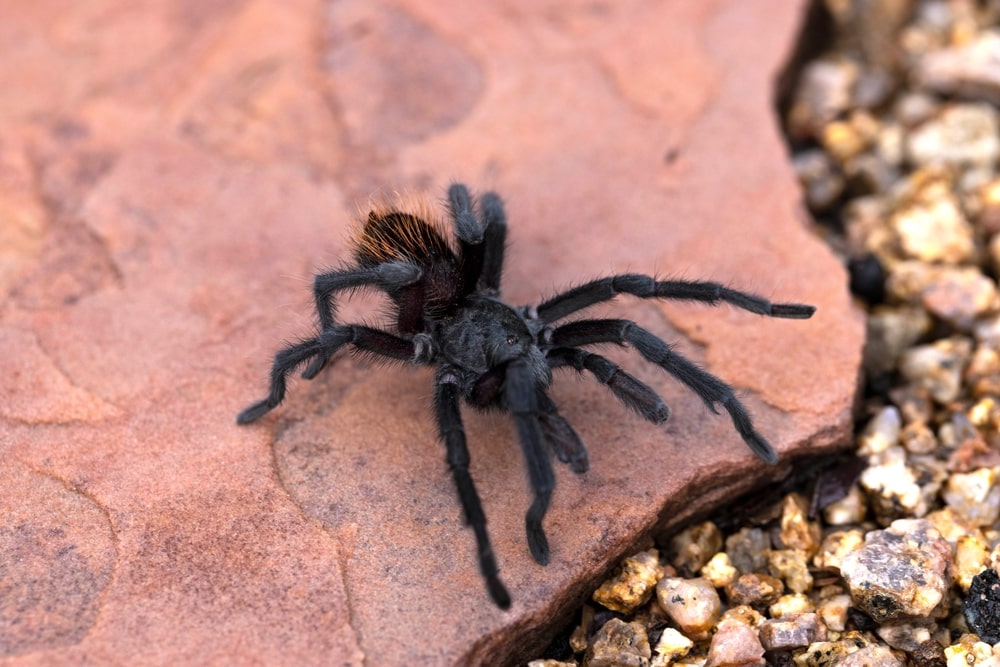
The Grand Canyon black tarantula is a native species of Arizona. It has a limited range, preferring the high elevations of the four corners area. They are also observed in and around the Grand Canyon, hence the name.
This species, formerly known as Aphonopelma behlei is dark brown to black. They have a sprinkling of orange and red hairs on their abdomen. They grow up to 4 inches (10.16 cm), with the males slightly smaller.
Both of these species feed on insects, small amphibians, reptiles, and rodents. After a large meal, they may not eat for a month. They are preyed upon by the tarantula hawk, which paralyzes them and lays eggs in them. The eggs hatch, and the larva eat the spider.
They are a new world species. They defend themselves by kicking urticating hairs into the eyes and mouths of would-be predators. They will also rear up in a defense pose to warn and scare off smaller predators.
Other Tarantula Spiders
- Great Basin Blonde Tarantula (Aphonopelma Iodius)
- Aphonopelma Mareki
- Madera Canyon Tarantula (Aphonopelma madera)
- Santa Catalina Mountain Tarantula (Aphonopelma catalina)
- Aphonopelma Parvum
- Aphonopelma Prenticei
- Aphonophelma Saguaro
- Superstition Mountains Tarantula (Aphonopelma superstitionense)
- Tucson Bronze Tarantula (Aphonopelma vorhiesi)
- Chiricahuan Gray Tarantula (Aphonopelma gabeli)
- Paloma Dwarf Tarantula (Aphonopelma paloma)
12. Wolf Spiders (Lycosidae)

From the ancient Greek meaning “wolf,” the family Lycosidae is made up of agile hunters. These fast-moving spiders have excellent eyesight.
Their distinct eye pattern is made up of three rows of eyes. The top row has two small eyes. The middle row has two large eyes. The bottom row has four eyes in a sort of frowny face shape.
Female wolf spiders carry their egg sacs with them wherever they go. When the babies hatch, they hop on the mother’s back. She then continues to carry them around for several weeks.
Contrary to common belief, wolf spiders do not attack humans. Their venom is not deadly, but a wolf spider bite could be very painful.
12.1 Carolina Wolf Spider (Hogna carolinensis)
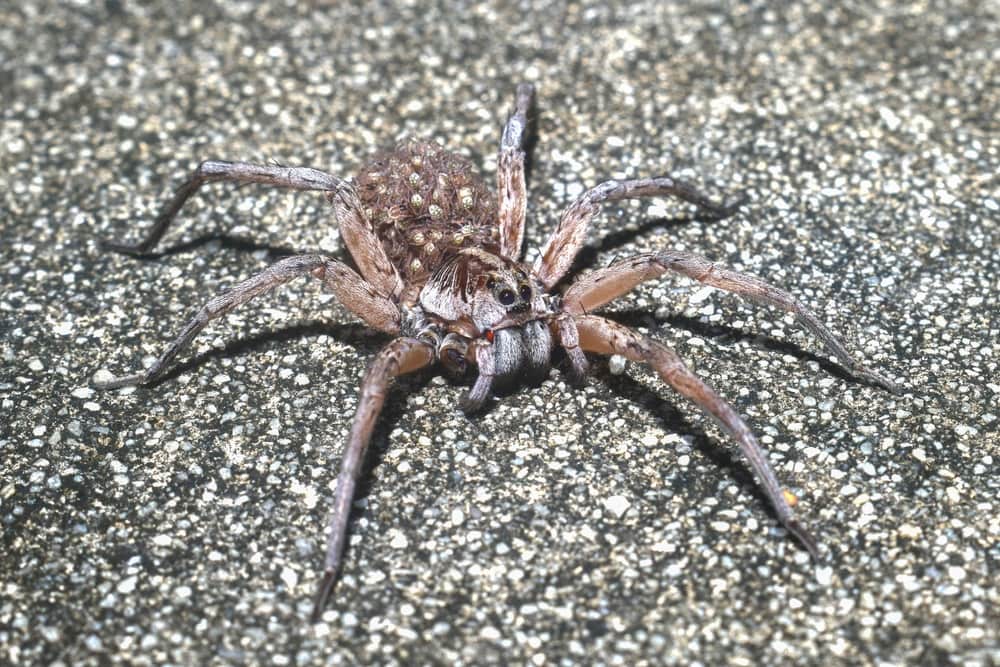
The Carolina wolf spider is the largest wolf spider species in North America. The females come in at about 3.75 inches (9.5 cm), including legs. The males are slightly smaller. They are mottled brown with dark undersides. The males show off orange markings on their sides.
They are fast and agile hunters that enjoy eating grasshoppers and crickets. They are solitary night hunters.
They produce eyeshine. If you shine a flashlight on the ground at night, you’re likely to see their eyes shining back at you. Unlike other spiders, wolf spiders build obvious burrows. They use their silk to entangle sticks and grasses to make an entryway.
Other Wolf Spiders
- Koch’s Wolf Spider (Alopecosa kochi)
- Shoreline Wolf Spider (Arctosa littoralis)
You May Also Like: The 20 Florida Spiders You Need To Know About (ID Guide And Pictures)
What Makes a Spider a Spider?
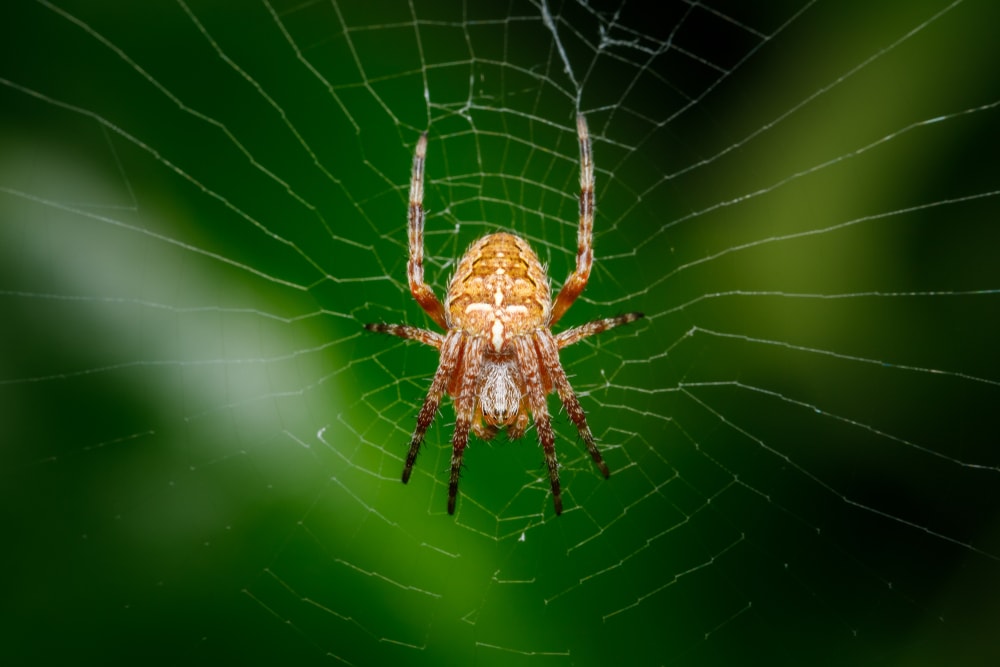
Spiders are members of the arachnid family. Arachnids are joint-legged invertebrates. Invertebrate means that they have hard exoskeletons instead of an internal skeletal structure. Arachnids typically have 8 legs.
There are several species classified as arachnids. These include scorpions, ticks, vinegaroons, and mites. Also included are camel spiders and harvestmen, commonly mistaken as daddy long legs. Neither of the latter is an actual spider.
So what makes a spider different from other arachnids? Spiders have eight legs used for walking. They also have a cephalothorax and an abdomen. The cephalothorax is a combined head and thorax. A shell-like covering called a carapace protects the cephalothorax.
Spiders generally have eight eyes, though some species have more or less. Each spider family has a different placement. A closer inspection of their eye pattern is a good way to differentiate spiders.
Spiders don’t have teeth, so they cannot chew food. Instead, they rub their prey with their jaws (chelicerae) and pedipalps. The chelicerae end in fangs. The fangs are filled with venom.
The venom is to paralyze and kill their prey. Pedipalps are the frontal limbs used for holding prey and mating. Using their jaws and pedipalps, they turn the edible bits into a goo they can eat.
At the base of the abdomen are the spinnerets. While not all spiders make webs, they do create silk. They use this silk for spinning webs or lining nests. They also make tethers and parachutes for when they’re on the move. Each spider species has adapted ways to use silk for specific needs.
You May Also Like: 27+ Types Of Spiders In Arkansas: ID Guide, Chart And Photos
FAQ
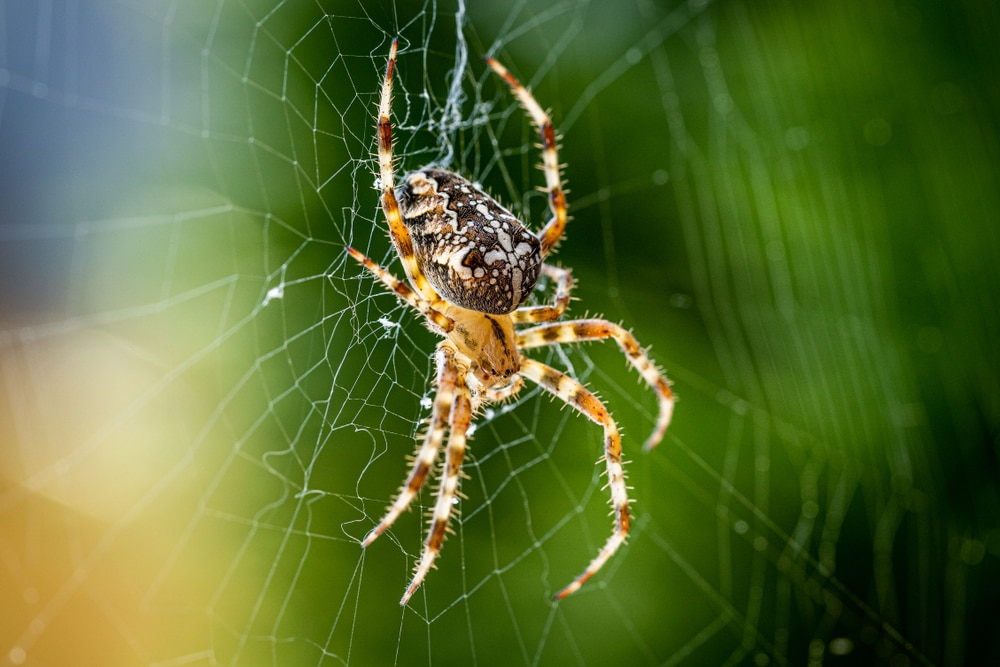
What should I do if I find a spider in my house?
The first thing to do is to stay calm. Don’t panic. Spiders do not want to actively harm you. Find a cup or a bowl, preferably a clear one that is bigger than the leg span of the spider. You’ll also need a piece of paper or thin cardboard.
Gently cup the spider, making sure not to pinch any of its legs. Slide the paper under the cup, making sure not to squish your new eight-legged friend. With the spider secure in the catch cup, take it outside. Deposit it on a tree or in a bush. Congratulations! You saved a spider.
Are spiders beneficial to the environment?
Yes! Spiders are excellent pest control. Spiders eat tons of nasty insects!
It’s estimated that if no spiders existed, there would be four feet (1.21 m) of insects on the ground at all times. Yuck! Can you imagine? Our crops and homes would be overrun with bugs. They eat lots of bugs that cause disease, too.
What is the most venomous spider in Arizona?
The most venomous spiders in Arizona are the black widow and the brown recluse. Both of these spiders have medically significant venom. It can cause serious harm and even death if left untreated.
The black widow bite is easy to recognize, as it feels like you’ve just touched searing hot coals.
The brown recluse inflicts an initial bite that is often unnoticed or unremarkable. The site of the bite may swell and become blistered.
How do I know what kind of spider bit me?
If the bite is extremely painful or burns, you have likely encountered a more venomous spider. The brown recluse and the black widow are the two spider bites with the most medically significant envenomation.
Please seek medical attention if a bite causes excruciating pain or a burning sensation that doesn’t dissipate.
If you experience fever, nausea, shortness of breath, or muscle cramping, please seek medical attention. If you see a spider near where you experienced the bite, bag it up and take it to your doctor. This will help them to identify the type of spider that may have bitten you.
Are Arizona tarantulas poisonous?
There are no poisonous spiders. The correct term is venomous, as poisonous refers to something you would have to eat to feel the toxic effects of. All spiders have venom. It’s what they use to paralyze and consume their prey.
Tarantulas are large spiders, and they eat large prey. Suffice it to say, they have strong venom. However, it is not deadly to humans. If a tarantula were to bite you, the bite would be painful and may sting for several days.
Tarantulas in Arizona do not have medically significant venom that is harmful to humans.








